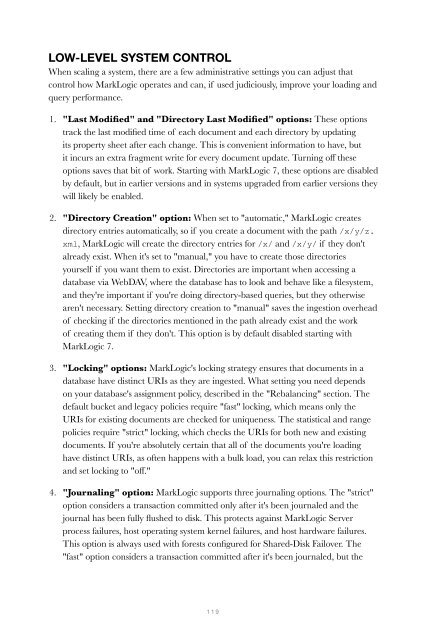Create successful ePaper yourself
Turn your PDF publications into a flip-book with our unique Google optimized e-Paper software.
LOW-LEVEL SYSTEM CONTROL<br />
When scaling a system, there are a few administrative settings you can adjust that<br />
control how MarkLogic operates and can, if used judiciously, improve your loading and<br />
query performance.<br />
1. "Last Modified" and "Directory Last Modified" options: These options<br />
track the last modified time of each document and each directory by updating<br />
its property sheet after each change. This is convenient information to have, but<br />
it incurs an extra fragment write for every document update. Turning off these<br />
options saves that bit of work. Starting with MarkLogic 7, these options are disabled<br />
by default, but in earlier versions and in systems upgraded from earlier versions they<br />
will likely be enabled.<br />
2. "Directory Creation" option: When set to "automatic," MarkLogic creates<br />
directory entries automatically, so if you create a document with the path /x/y/z.<br />
xml, MarkLogic will create the directory entries for /x/ and /x/y/ if they don't<br />
already exist. When it's set to "manual," you have to create those directories<br />
yourself if you want them to exist. Directories are important when accessing a<br />
database via WebDAV, where the database has to look and behave like a filesystem,<br />
and they're important if you're doing directory-based queries, but they otherwise<br />
aren't necessary. Setting directory creation to "manual" saves the ingestion overhead<br />
of checking if the directories mentioned in the path already exist and the work<br />
of creating them if they don't. This option is by default disabled starting with<br />
MarkLogic 7.<br />
3. "Locking" options: MarkLogic's locking strategy ensures that documents in a<br />
database have distinct URIs as they are ingested. What setting you need depends<br />
on your database's assignment policy, described in the "Rebalancing" section. The<br />
default bucket and legacy policies require "fast" locking, which means only the<br />
URIs for existing documents are checked for uniqueness. The statistical and range<br />
policies require "strict" locking, which checks the URIs for both new and existing<br />
documents. If you're absolutely certain that all of the documents you're loading<br />
have distinct URIs, as often happens with a bulk load, you can relax this restriction<br />
and set locking to "off."<br />
4. "Journaling" option: MarkLogic supports three journaling options. The "strict"<br />
option considers a transaction committed only after it's been journaled and the<br />
journal has been fully flushed to disk. This protects against MarkLogic Server<br />
process failures, host operating system kernel failures, and host hardware failures.<br />
This option is always used with forests configured for Shared-Disk Failover. The<br />
"fast" option considers a transaction committed after it's been journaled, but the<br />
119


